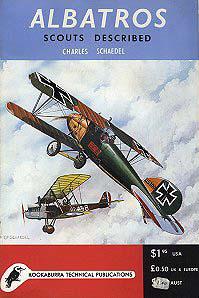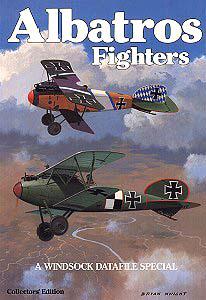|
Albatros DVa D5390/17Albatros DVa D5390/17http://members.nbci.com/_XMCM/otprojects/albatros/index.html History On the 17th of December 1917, six Albatrous Scouts dived on a 3 Sqn Australian Flying Corps RE8 A3816 of Sandy and Hughes. In the ensuing fight the pilot of the Albatros D5390/17 was wounded by a bullet fired from the twin Lewis guns of Hughes. The Albatros came down and landed fairly gently behind the lines of the 21st Infantry Battalion of the Second Australian Division, AIF.
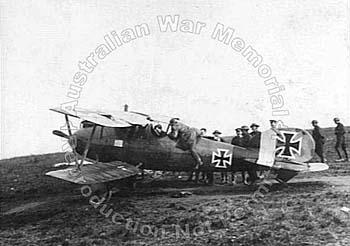 German Albatros DVa Scout 5390/17 A German Albatros DVa Scout aircraft Serial No. 5390/17 brought down by members of the Australian Flying Corps, near Armentieres on 17 December 1917. Both the airmen concerned, Lieutenant L. Sandy and Sergeant Gunner H. F. Hughes, were killed in the engagement and their machine flew uncontrolled for many miles before landing. This image may have been the first taken of the aircraft as it seems distant from the Squadron's tents etc. and seems to show members of field troops [21st Infantry Battalion of the Second Australian Division, AIF. mentioned above? Ed.] Australian War Memorial Negative Number: H18970 You may wish to download a 500pixel version of this image
A second RE8 of Jones and Hodgson from 3 Sqn attempted to rescue the RE8 of Sandy and Hughes, Hodgson firing 400 rounds in the ensuing battle. A third RE8 from 3 Sqn was moving to join the fight when the Albatros Scouts broke off. Jones flew close to Sandy's machine but neither Sandy or Hughes acknowledged the other RE8. Jones and Hodgson assumed everything was alright as Sandy and Hughes's aircraft was flying fine. Jones and Hodson broke off to Bailleul for more ammunition. The Squadron didn't hear from Sandy and Hughes that night. A telegram from the 12th Stationary Hospital at St Pol arrived the next morning with the information that the dead bodies of Sandy and Hughes had been recovered from a field where they had safely landed 3 miles outside of St Pol. Captain Ross of 3 Sqn was sent to the crash site and discovered the aircraft had landed with the throttle wide open from a steep descent. The only damage from the landing being a broken propeller and a slightly crumpled right wing. The post mortem of Sandy and Hughes came to the conclusion they had been killed by the same armour piercing bullet that had passed through Hughes lung and into the base of Sandy's skull. The squadron managed to piece together what had happened the previous day. Sandy and Hughes had been killed in the fight with the six Albatros aircraft. Their aircraft had flown in wide circles until the RE8's fuel tanks were empty and with a strong North East wind, the RE8 had drifted in wide circles to St Pol, 50 miles away. The RE8 of Sandy and Hughes is often referred to as the "Ghost RE8". The Albatros Scout D5390/17 was recovered by the Australian Infantry and then transported to 3 Sqn Australian Flying Corps aerodrome at Bailleul. The aircraft was then shipped by the order of 2nd Brigade Royal Flying Corps to No.1 Supply Depot at St Omer and given the "G" Number G101. The aircraft was test flown in England before finally being presented to the Australian Government as a War Trophy. The aircraft was displayed until 1948 when it was removed from the public eye due to a dilapidated condition and stored at the Military Academy at Duntroon. While at Duntroon it was damaged by vandals, a chunk was broken off from the propeller, a hole kicked in the ply skin and a Spandau gun removed. Though the gun was later recovered. In 1966 - 68 the Albatros was moved to Camden in Sydney where it was restored to it's present day condition. The Albatros was on display in the Australian War Memorial's Aircraft Hall until 1999 when it was moved to the Treloar Centre for reconditioning and restoration.
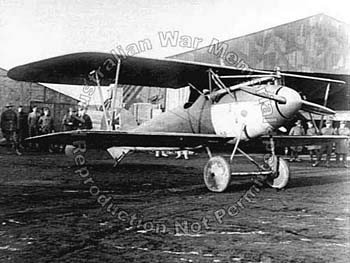 German Albatros DVa Scout A German Albatros DVa Scout aircraft Serial No. 5390/17 brought down by members of the Australian Flying Corps, near Armentieres on 17 December 1917. Both the airmen concerned, Lieutenant L. Sandy and Sergeant Gunner H. F. Hughes, were killed in the engagement and their machine flew uncontrolled for many miles before landing. Australian War Memorial Negative Number: E01684. G.J. Thomas Collection You may wish to download a 500pixel version of this image
Markings The following information is (to the original site) courtesy of Chris Shephard. The information in the [] brackets denotes D5390/17's current non original markings.
Dark green fuselage from rear cabane attachment point to front of tail planes from the lower longeron up, it continued over the top of the fin to the rear of the timberwork. The starboard area of the fin was dark green but the port remained varnished exposing the 5390/17. The normal early style crosses were untouched on both sides. Rudder was green on both sides without covering the crosses.the outline of the side crosses showed through on the fuselage sides as a raised area. Undersides of the stabilizers and elevator was Buff. Cockpit leather was dark brown. Gray timber wheel disks [green,aluminium]. Varnished under carriage foils [green upper/blue lower sides]. All struts and under carriage was khaki brown except for outer V struts in light grey [all now dark green]. All metal cowls and hatches were khaki brown [dark green]. Upper wings had green on either tip, starboard side began at the 2nd rib from aileron root to right of the cabane attachment bolt plate. This aileron was in 5 colour fabric as combat damage had occured previously. The port side was also green naturally this began level with the cabanes on the t/e and ended 1/4 of the way out to the V struts (from the cabanes), all remaining upper side center section were in mauve. [5 colour hand sprayed,top and bottom]. Port lower wing had a mauve inboard area 1/2 rib out at the t/e running to 3 ribs out at the L/e. The mauve began again at 8th rib on the T/e and ended at the 9th on the L/e. center was dark green [lozenge]. Starboard lower wing was dark green from the root to between 5th and 6th rib at the T/e to between 4th and 5th rib at the L/e. Dark green began again at the 4th rib from the tip at the L/e and ran to the 3rd rib from the tip at the T/e. In between was mauve [lozenge]. Undersides of top wings were printed in 5 colour pattern. Underside of lower wings were sky blue as per earlier types. It is apparent that the CO ordered the 5 colour pattern to be overpainted with the earlier blue/green/mauve to match existing units on strength. One assumes that the upper wing underside was due to be painted soon, however I'm (Chris Shephard) sure the mechanics didnt get the afternoon of 17th December off. The finish of the upper sides of the stabilizer is the sticking point, the outer bay of the stabilizers was dark green and the inboard 2 bayslight blue. ditto for the elevator but the light blue went right across to the next area of green, the fuselage dark green was not continued onto the elevator here. Where the two colours met there was apparently a red line (about 50mm wide) that wrapped around the stabilizer, but not the elevator. This line I (Chris Shephard) have been informed was actually the 'same' purple as that in the 5 colour print,and continued the full way around the whole tailplanes. [light blue undersides, lozenge uppers].
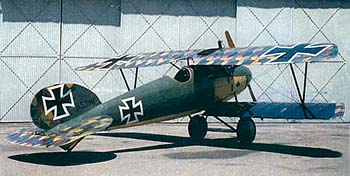 German Albatros DVa Scout Serial No. 5390/17, shortly after restoration, Australian War Memorial, Canberra, Australia, c.1960 Albatros DVa Scout No. 5390/17 was brought down by members of the Australian Flying Corps, near Armentieres on 17 December 1917. Both the airmen concerned, Lieutenant L. Sandy and Sergeant Gunner H. F. Hughes, were killed in the engagement and their machine flew uncontrolled for many miles before landing. Australian Society of World War 1 Aero Historians You may wish to download a 500pixel version of this image
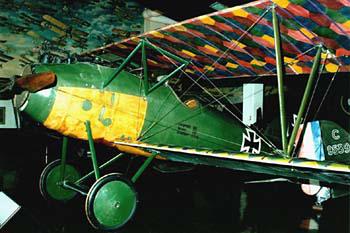 German Albatros DVa Scout Serial No. 5390/17, Australian War Memorial, Canberra, Australia, c.1995 Albatros DVa Scout No. 5390/17 was brought down by members of the Australian Flying Corps, near Armentieres on 17 December 1917. Both the airmen concerned, Lieutenant L. Sandy and Sergeant Gunner H. F. Hughes, were killed in the engagement and their machine flew uncontrolled for many miles before landing. Photo : Charles Hart, July, 1995 http://www.wwi-models.org/Photos/Ger/Alb_DV/ You may wish to download a 500pixel version of this image
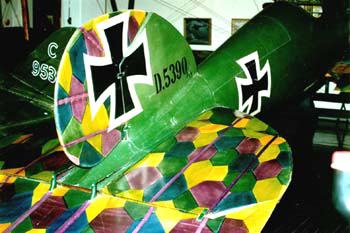 German Albatros DVa Scout Serial No. 5390/17 on display at the Australian War Memorial, Canberra, Australia, 1995 Albatros Scout DVa No. 5390/17 was brought down by members of the Australian Flying Corps, near Armentieres on 17 December 1917. Both the airmen concerned, Lieutenant L. Sandy and Sergeant Gunner H. F. Hughes, were killed in the engagement and their machine flew uncontrolled for many miles before landing. Photo : Charles Hart, July, 1995 http://www.wwi-models.org/Photos/Ger/Alb_DV/ You may wish to download a 500pixel version of this image
The photographer also notes for the above two images...
"This machine was ... restored during the 1960's" "The markings worn at capture are represented ...[with] ...the wings ... recovered in new fabric to represent 5-color lozenge. Note how the pattern is applied span-wise across the wings. The lower surfaces of the lower wing are overpainted in light blue and have plain eiserne kreuze with no white outline."
Miscellaneous Aircraft in Australia D.5390/17 Albatros DVa Australian War Memorial, Canberra 15/11/68 downed in combat over France on December 17th 1917 by an Australian R.E.8.
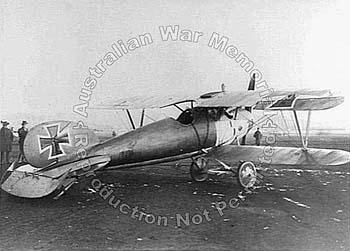 German Albatros DVa Scout A German Albatros DVa Scout aircraft Serial No. 5390/17 brought down by members of the Australian Flying Corps, near Armentieres on 17 December 1917. Both the airmen concerned, Lieutenant L. Sandy and Sergeant Gunner H. F. Hughes, were killed in the engagement and their machine flew uncontrolled for many miles before landing. Identified, left to right: Second Air Mechanic A. M. Lovegrove; Sergeant Mechanic P. J. Pearce; Chief Mechanic V. Ennis. Australian War Memorial Negative Number: E01686 You may wish to download a 500pixel or 750pixel version of this image
The Thelen and Schubert Albatros Scout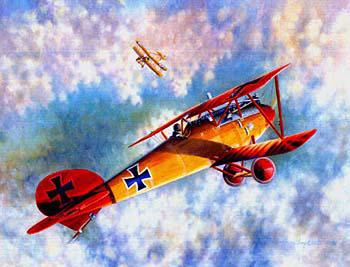 "Von Richthofen" © Troy White, Oil on Canvas, 34" x 44" http://www.starduststudios.com/gallery4.htm You may wish to download a 500pixel version of this image
"Rittmeister Manfred Freiherr von Richthofen, Kommandeur of Jasta 11 (one of the four Jastas that comprised the newly designated Jagdegeschwader Nr. 1) banks his Albatros DVa 4693/17 as his opponent of Royal Flying Corps No. 20 Squadron turns his F.E.2d into him on July 6, 1917. Moments later Von Richthofen, known as the Red Baron, was wounded by a single round fired by observer/gunner A.E. Woodbridge. The bullet grazed Von Richthofen's scalp, rendering him temporarily unconscious. He came-to in a nearly vertical dive and managed to make an emergency landing behind his own lines. Out of action for 6 weeks, the Baron would never quite recover from his wound and suffered from headaches for the rest of his life." http://www.starduststudios.com/gallery4.htm
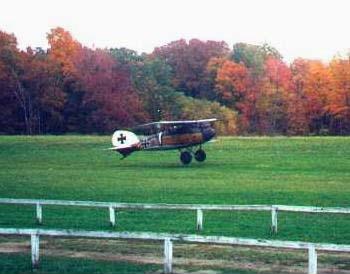 One of the two last airworthy Albatros at the Rhinebeck Air Museum
Albatros-Flugzeugwerke The Albatros-Flugzeugwerke factory opened it's doors at Johannistahl in 1910. By 1914 the company was designing and building B and C Class aircraft. In early 1916 the Fokker EIII was being superceded by faster, more powerful entente biplanes and the Albatros' answer was Thelen and Schubert design, the DI Scout. The fuselage was a semi-monocoque construction giving lightweight and high strength.
The Albatros series of single-seat fighters produced between 1916 and 1918 were among the most numerous and distinctive aircraft of the First World War. The Albatros Werke began to build airplanes in 1910. Early in the war , the firm focused on two-seat observation types. In 1916, in response to the fading superiority of the Fokker monoplane to the French Nieuport 11 and the British de Havilland D.H.2, the German government requested the nation's aircraft companies to produce a suitable replacement for the Fokker.
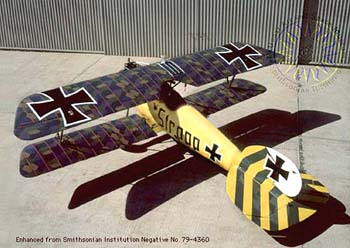 Albatros DVa D.7161/17 "Stropp" http://www.nasm.edu/nasm/aero/aircraft/albatros.htm
Albatros Werke chief designer, Robert Thelen, with his assistants Gnaedig and Schubert, offered a remarkably advanced design, the Albatros D.I. It featured a streamlined semi-monocoque fuselage, with an almost fully-enclosed in-line Mercedes engine and the propeller spinner neatly contoured into the nose of the fuselage. The D.I was quickly modified into the very similar D.II, which had the upper wing repositioned slightly to improve visibility for the pilot. Both fighters entered front-line service in the fall of 1916 and immediately demonstrated strong advantages over their Allied counterparts. Powered by a 160-horsepower Mercedes engine and armed with two machine guns, the Albatros fighters used speed and firepower to overwhelm the lighter, more maneuverable Nieuports and D.H. 2s. Even before the success of the Albatros D.I and D.II was fully realized, Thelen was already developing an improved model. The Albatros D.III was introduced early in 1917 and it met with instant acceptance by the German pilots. It was easy to fly and was an effective combat aircraft. The principal design change was the use of a narrow-chord lower wing, similar to the sesquiplane wing arrangement of the agile Nieuport fighters. This increased maneuverability as well as improving the pilot's field of view. Initially, the narrow lower wing was susceptible to frequent failure in prolonged dives, but with reinforcement of the structure and improved workmanship, the problem was ameliorated. The Albatros D.III served with great success throughout the first half of 1917. Beginning in mid-1917, however, with the introduction of the British S.E. 5 and the French Spad VII, German air superiority waned once again. Thelen was forced to refine the sleek Albatros design further in an effort to gain parity with the new Allied fighters. In the D.IV model, Thelen reverted to the equal-width upper and lower wings of the D.I and D.II. The nose was even more streamlined than the D.III and the rudder had a more rounded shape. An experimental geared version of the 160-horsepower Mercedes engine was fitted to the D.IV prototype. But despite its racy appearance, the performance of the D.IV was not up to that of the D.III, and the experimental geared engine was problem-ridden. Thus, no production run of the D.IV was ordered. The Albatros D.V returned to the sesquiplane wing design of the D.III. Initially it was powered by the same 160-horsepower Mercedes engine used in the D.III, but later it was replaced by an up-rated model that delivered approximately 180 horsepower. The major new innovation was the D.V's elliptical cross-section fuselage, compared to the flat-sided fuselage of the earlier models. Primarily because of changes in the nature of the construction of the elliptical fuselage, the D.V was approximately 32 kg (70 lb) lighter than the D.III, and this improved performance marginally. But hopes for the new version were soon undermined by a rash of upper wing spar failures shortly after the D.V was introduced. To remedy the problem, the wing ribs and the spars were strengthened, resulting in a re-designation, the D.Va. Unfortunately, the necessary strengthening of the airframe made the overall weight of the D.Va 23 kg (50 lb) more than the D.III, negating the performance improvement of the newer model. Even so, the D.Va remained in production until April 1918, when the superior Fokker D.VII appeared. Approximately 4,800 Albatros fighters of all types were built during World War I. They were used extensively by the German Air Service throughout 1917, and remained in action in considerable numbers until the end of the war. Many of the highest-scoring German aces achieved the majority of their victories while flying Albatros fighters. Although most often associated with the novel Fokker Triplane, the famed Red Baron, Manfred von Richthofen, won three-quarters of his 80 combat victories in Albatros aircraft. Despite the large production and pervasive presence of the Albatros fighters during World War I, only two have survived, and both are D.Va models. One is at the Australian War Memorial Museum in Canberra, Australia, serial number D.5390/17. The other is in the collection of the National Air and Space Museum. The early history of the NASM Albatros is very sketchy. During the restoration of the airplane by NASM, the serial number D.7161/17 was discovered under several layers of paint on the fin. This places it in the final batch of 550 D.Vas built by the Albatros factory during the war. The last of these aircraft reached the front in April 1918. It is apparent, however, that the airplane is comprised of components from more than one Albatros. The individual wings show evidence of workmanship of different quality, suggesting that they were not produced at the same time and at the same place. Further, before restoration, there were straight crosses as well as the earlier Iron Cross national insignia on different components of the airplane. Another clue to the history of the NASM Albatros was revealed during restoration. The original layer of paint showed green and yellow stripes on the tail. This was the marking for the German squadron Jasta 46. This unit was formed at Graudenz on December 17, 1917, as part of Germany's Amerika Program, an effort to build up German strength rapidly and deliver a decisive blow to the West before American resources could be brought to bear for the Allies. Under the program, the number of German fighter units doubled. The inferred production date from the serial number of the NASM Albatros fits with the creation and equipping of Jasta 46 with Albatros fighters. Evidence that the NASM Albatros did see combat is damage from a bullet that passed through the right machine gun mount, penetrated the emergency fuel tank, and then lodged in the right magneto. The airplane was unlikely to have flown again as the fuel tank had not been repaired. The distinctive personal marking of "Stropp" on the fuselage side remains a mystery. Some have suggested that stropp can be interpreted to mean a precocious or mischievous boy, but no record confirming this, or even with whom the marking was associated, has been found. The history of the airplane for the remainder and immediate aftermath of the war remains unknown. The first record of the NASM Albatros in the United States is the presentation of the airplane to the De Young Memorial Museum in San Francisco on July 13, 1919, by Congressman Julius Kahn. It is unclear how Congressman Kahn became associated with the Albatros, but a label placed with the airplane at that time credited it as a gift from the French government. Some years later, NASM curator Paul Garber learned of the Albatros at the De Young Memorial Museum. On a trip to California in January 1947, he located the airplane and approached the museum about donating it to the Smithsonian. Garber was informed that it had recently been sold at auction for $500.00 to George K. Whitney, who planned to display it at Playland near Cliff House, a local San Francisco tourist stop. After Garber explained the importance of the historic aircraft to Whitney, he agreed to donate it to the Smithsonian, with the condition that the museum pay the packing and transportation costs. After a lengthy delay until funds were available, the Albatros was moved to the museum's temporary storage facility in Park Ridge, Illinois, in August 1949. It was brought to Washington, D.C., in 1952 and remained in storage until restoration began in January 1977. The complex and meticulous rebuilding of the NASM Albatros D.Va was completed in February 1979.
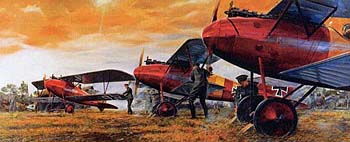 Circus rolls at Dawn "Richthoven's squadron prepares to take off to patrol in their Albatros DV's" http://www.oldgloryprints.com/Dietz.htm You may wish to download a 500pixel or 750pixel version of this image
Albatros DV and DVa http://www.aviation-history.com/albatros/d5.htm The tremendous success of the Albatros Scouts in the early months of 1917 encouraged a feeling of complacency in the IdFlieg (Inspectorate of Flying Troops). It was felt that the Albatros Werke would continue to produce war winning fighters. By May 1917 such Allied types as the Spad, Sopwith Pup and Triplane and the S.E.5, each able to out fly the Albatros DIII were appearing in numbers. With some dismay it was then realized that the new Albatros DV was little better than its predecessor. The engine fitted to the D-V was the 180 h.p. Mercedes (the 160 h.p. Mercedes with an increased compression ratio). The 220 h.p. Mercedes and the 200 h.p. Benz were installed experimentally. The radiator was set in the top wing to starboard of the centre-line; machines operating in Palestine had two radiators. Wings, interplane struts and tail were identical to those of the D-III, but the D-V's aileron cables passed through the top wing and had small shrouds, while the D-III's ran through the lower wing and thence up to crank levers on the top wing. The prototype's rudder had a straight trailing-edge, but later machines had trailing-edges of rounded outline. The lower fin was taken back to the horizontal knife-edge of the fuselage --the D-III's lower fin terminated below the rudder-hinge line. In contrast to the flat-sided D-II fuselage, that of the D-V was oval in cross-section and deeper, so that there was a smaller gap between it and the top plane. A faired head-rest was fitted behind the cockpit, but it was frequently taken off. The undercarriage was of the steel tube type with a fairing over the axle, which provided extra lift. Twin synchronized guns were mounted. The D-Va differed from the D-V in having aileron cables as on the D-III. Its head-rest was generally removed to improve the pilot's view rearwards.
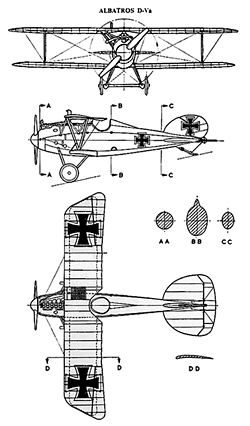 German Albatros DV, 3view You may wish to download a 350pixel or 500pixel version of this image
The Jagtlstaffeln received the D-V in May 1917; the D-Va was supplied in the following month. From the beginning fatal crashes, caused by wing failure, occurred, and extra bracing wires were added to remedy wing flutter. In order to prevent the twisting of the single spar of the lower wing under stress, small struts were taken from the leading edge to the lower part of the interplane struts. Finally, the factory fitted a metal box-like sleeve to the center section of the lower wing; the sleeve enclosed the main spar and strengthened it. The aircraft parks were ordered to modify those machines already issued, but subsequently an Albatros official visiting the front discovered that this work had not been done, and that wing failures were still occurring! Even after these alterations, pilots were advised not to dive too steeply, which hardly raised their morale. Nevertheless the type was used in large numbers, for the only alternatives were the suspect Fokker Triplane and the second-rate Pfalz D-III and many machines were still in operational use up to the time of the Armistice. The DV/Va flew in Italy with German units, and operated in Palestine. Machines built by the Ostdeutsche Albatros Werke were designated Alb. D-V or D-Va (O.A.W.). When the Albatros types were redesignated after the war (in order to circumvent the terms of the Armistice), the DV/Va was given the title L.24.
Further Reading
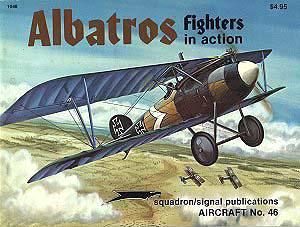
Online
Albatros DV - M. von Richthofen
Albatros DVa 1/72nd Scale Eduard Kit No.7019
Blauer Max-Flugzeuge Albatros DV
German Aviation 1914-1918 (1917)
|
© Copyright 1999 CTIE - All Rights Reserved - Caution |
